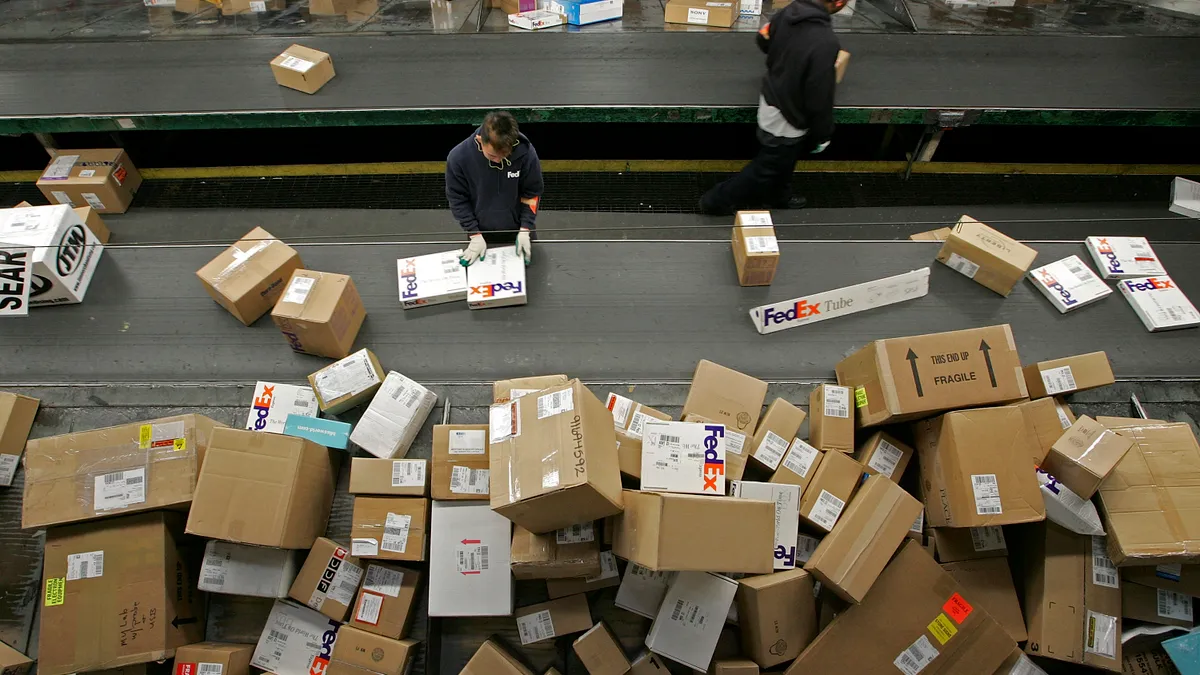Dive Brief:
- FedEx will increase various surcharges for peak season in line with rival UPS, setting up another costly holiday season for companies shipping high volumes with the major parcel carriers.
- Starting Oct. 4, FedEx will raise its surcharges for packages that require additional handling, are oversized or are unauthorized for its Ground network through Jan. 16, 2022. FedEx will also implement per-package surcharges for Ground Economy shipments, which peak at $3 from Nov. 29 to Dec. 12.
- Customers shipping more than 25,000 packages on average per week will be charged for residential packages shipped between Nov. 1 and Jan. 16, 2022, based on how many more packages the customer ships compared to volumes they sent in February 2020.
Dive Insight:
FedEx is pushing current surcharges, focused on Express and Ground home delivery services, to higher levels during peak season as shippers fight for limited space in parcel carriers' networks. The additional handling and oversized surcharges will rise from $3.50 to $5.95 and $30 to $62.50.
FedEx said on its website the surcharges are necessary to keep service levels high.
"We are entering another holiday peak season during which we expect continued high demand for capacity and increased operating costs across our network," FedEx said. "We again anticipate the surge in residential volume to carry over into the new year."
FedEx and UPS have instituted an array of surcharges because package volumes have surged during the COVID-19 pandemic. Although both carriers have made sizable investments in their networks, UPS expects the industry's demand to exceed capacity by 5 million pieces daily during peak. Shippers are diversifying by shifting more volume to regional carriers, but capacity is still hard to come by.
The volume spike shows no signs of abating — FedEx is already setting $0.60 per-package surcharges to begin Jan. 17, 2022, for Express and Ground home deliveries in the U.S. No end date was listed.
"Although not a surprise peak surcharges will continue in 2022, FedEx is the first to put it in writing," Nate Skiver, founder of consulting firm LPF Spend Management, wrote on LinkedIn. "For those shippers who thought the door had closed to diversify their carrier base before peak season, you may want to re-open it. If not for peak season, then kick it open in January."
FedEx and UPS have made it clear they're prioritizing more profitable shipments from small- and medium-sized businesses and sectors like health care, since volume itself hasn't been hard for them to come by.
"We will continue to confidently renegotiate our large customer segment contracts to increase profitability," FedEx Chief Marketing and Communications Officer Brie Carere said on the company's Q4 earnings call. "This means balancing product, day of week and lane mix at the customer level, while ensuring appropriate surcharges and rate increases cover rising labor costs."
FedEx's peak residential delivery charge, for example, only affects high-volume customers. But the 25,000-package weekly average volume threshold is lower than last year's 35,000. This is similar to the approach UPS announced for its 2021 peak surcharges, and Carere said companies paying this surcharge are helping cover the additional labor costs FedEx sees during peak.
"Those that have the highest peaking factor really pay for the incremental labor at peak," Carere said, referring to the metric the carrier uses to measure shipper volume increases compared to February 2020.
FedEx peak surcharges, Nov. 1, 2021 to Jan. 16, 2022
| 110% to 200% of weekly average volume, Feb. 3, 2020 to March 1, 2020 | More than 200% to 350% | More than 350% to 500% | More than 500% | |
|---|---|---|---|---|
| FedEx Ground, U.S. residential | $1.15 | $2.25 | $3.50 | $5.00 |
| FedEx Express, U.S. residential | $2.15 | $3.25 | $4.50 | $6.00 |
SOURCE: FedEx. Applies to customers shipping more than 25,000 packages per week.
Rob Martinez, founder and co-CEO at Shipware, said in an email that many FedEx enterprise customers have contract stipulations preventing the carrier from seeing some or all of the revenue from the surcharges. But FedEx is also issuing off-contract rate increases to some of its largest e-commerce shippers to increase revenue and free up capacity, Martinez said. Excess volume that shippers take elsewhere will likely fall to the U.S. Postal Service — which is planning peak surcharges of its own.
"High volume shippers shouldn't take these charges laying down," Martinez said. "They're negotiable."















